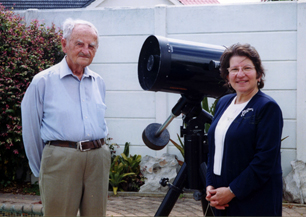AAVSO observer Raymond Winslow (Win) Jones passed away on 28 February 2007 at age 98.
Although he only started doing variable star observing at age 80, Win contributed over 15000 visual observations of variable stars to the AAVSO database. When his eyesight started failing due to macular degeneration, he took up photoelectric photometry (PEP) at age 88, and contributed close to 3000 PEP observations before bad health forced him to give up observing at the end of 2005. He received two Observer Awards from AAVSO: one for more than 10,000 visual observations, of which nearly 4,000 were for the Hipparcos project; the other for more than 1000 PEP observations.
When Janet Mattei visited us in South Africa at the end of 2002, she asked Win to start monitoring eta Carinae with his PEP equipment. He contributed a good number of high-quality eta Carinae PEP observations to the AAVSO database from 2003 to 2005.
 |
| Janet Mattei and Win Jones with his 11-inch Celestron in Fish Hoek, Cape Town, December 2002, when Janet joined us for brownies and tea. |
Win's interest in astronomy goes back much further than 1989 when he started observing variable stars. During his student years at the Massachusetts Institute of Technology (MIT), he bought a book about telescope making. Shortly after graduating in aeronautical engineering from MIT in 1929, he tried his hand at making a 6-inch telescope mirror from the book's instructions while working at a small factory in Baltimore (which made prototypes of military aircraft). However, attempting to make a telescope mirror did not go without frustration. At that time, the proper thickness of plate glass for the mirror disc was not available in Baltimore. Consequently the mirror failed the Foucault knife edge test because of warping of the too-thin disc. Win then obtained a small un-mounted telescope with which he recalled observing the Andromeda galaxy and a transit of Mercury.
In 1983 Win bought a 4-inch Newtonian reflector and a star atlas. The sightseeing possibilities of the 4-inch reflector were soon exhausted, so he started looking for something useful to do with it. The atlas suggested observing double stars, but that did not interest him. It was then that he remembered his old telescope making book of the late nineteen twenties which suggested observing variables for the American Association of Variable Star Observers (AAVSO) - this in a book published only about a decade after AAVSO was founded!
Win wrote to AAVSO who sent him a starting kit of charts for four Southern hemisphere variables and put him in touch with Jan Hers, director of the variable star section of the Astronomical Society of Southern Africa (ASSA), for further assistance.
Win's early visual observations were made with the 4-inch reflector. After correspondence with Jan Hers, he bought an 8-inch Celestron Schmidt-Cassegrain with which most of his visual observations were made. He fondly remembers one occasion on which AAVSO asked him for particular visual observations. That was when Janet Mattei asked Win by way of Jan Hers to keep an eye on VW Hydri.
By late 1995 it was obvious that his time for observing visual variables was drawing to an end because of failing eyesight. At the time, his eyesight was still good enough to navigate between stars. I, therefore, suggested photo-electric photometry, and he immediately took a keen interest. As he was then already reading with the aid of a magnifier glass, I indicated the most important sections in Astronomical Photometry, Text and Handbook for the Advanced Amateur and Professional Astronomer by Arne Henden and Ronald H. Kaitchuck as reading to help him decide whether he wanted to explore PEP. Win soon afterwards ordered an Optec SSP-5 photometer and got in touch with Howard Landis, then chairman of the AAVSO PEP committee, who assisted him in getting started with PEP. In the meanwhile he changed telescopes to an 11-inch Celestron and the first PEP observations were taken on 1 Jan. 1997 with his new equipment.
Win was unable to see any comparison, check and variable stars in his telescope's finderscope to help him navigate between stars. He thus had to find another way of moving between comparison, check and variable stars. He solved this problem by taking careful measurements of the distances between the stars in a given observing sequence using the Papadopoulos True Visual Magnitude Photographic Star Atlas. He used these measurements to calculate the number of 'counts' (seconds) that he needed to hold down the right ascension and declination buttons on his telescope's hand controller to move from one star to the next. He described this technique in more detail in Observing Southern Circumpolar Variables (Jones, W., MNASSA, Vol. 60, Nos. 11 & 12, December 2001).
Apart from the publication above, Win published Twelve Years of Observing at Fish Hoek (Jones, W., MNASSA, Vol. 60, Nos. 3 & 4, April 2001). Of particular interest to observers in the Southern hemisphere is Polar Alignment of Telescopes in the Southern Hemisphere (de Villiers, S. N. & Jones, W., MNASSA, Vol.54, Nos. 11 & 12, December 1995).
On a more personal note: Win's dedication, ingenuity and perseverance (in spite of ill health) serve as a huge source of inspiration to me and will hopefully also inspire other AAVSO observers. I'll miss our regular variable star discussions and the brownies (the best in the world!) and tea that always accompanied these sessions.
Fanie de Villiers
March 2007


